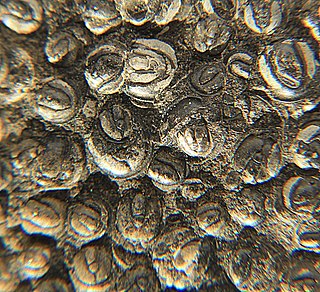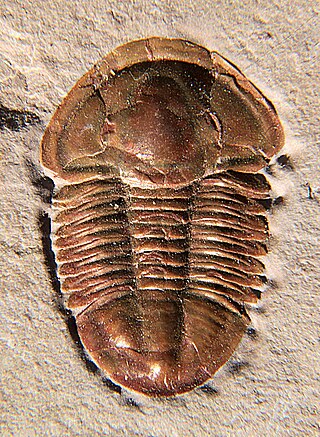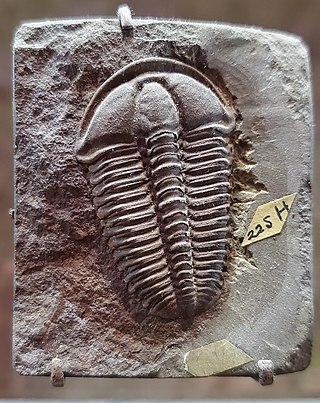Related Research Articles
Battus may refer to:
The Treatise on Invertebrate Paleontology published by the Geological Society of America and the University of Kansas Press, is a definitive multi-authored work of some 50 volumes, written by more than 300 paleontologists, and covering every phylum, class, order, family, and genus of fossil and extant invertebrate animals. The prehistoric invertebrates are described as to their taxonomy, morphology, paleoecology, stratigraphic and paleogeographic range. However, taxa with no fossil record whatsoever have just a very brief listing.

Phacops is a genus of trilobites in the order Phacopida, family Phacopidae, that lived in Europe, northwestern Africa, North and South America and China from the Late Ordovician until the very end of the Devonian, with a broader time range described from the Late Ordovician. It was a rounded animal, with a globose head and large eyes, and probably fed on detritus. Phacops is often found rolled up ("volvation"), a biological defense mechanism that is widespread among smaller trilobites but further perfected in this genus.

Agnostus is a genus of agnostid trilobites, belonging to the family Agnostidae, that lived during the late Middle Cambrian – early Upper Cambrian. It is the type genus of the family Agnostidae and is subdivided into two subgenera, Agnostus and Homagnostus.

Calymene Brongniart, 1822, is a genus of trilobites in the order Phacopida, suborder Calymenina, that are found throughout North America, North Africa, and Europe in primarily Silurian outcrops. Calymene is closely related to Flexicalymene, and both genera are frequently found enrolled. Calymene trilobites are small, typically 2 cm in length. The cephalon is the widest part of the animal and the thorax usually has 13 segments.
Eophacops is a genus of trilobites from the order Phacopida, family Phacopidae. These trilobites lived during the Middle Silurian in what now are North America and North-West Europe. Species assigned to this genus can be distinguished from Phacops by their small size (2–3 cm). Eophacops has very large eyes compared to the rest of its body.

Asaphus is a genus of trilobites that is known from the Lower and Middle Ordovician of northwestern Europe.

Acaste is a genus of extinct trilobite of the order Phacopida which lived throughout the Silurian period. Though many species had been included, it now has only one species, Acaste downingiae. It is characterized by a convex dorsal surface, an absence of spines, a shortening of the head-shield and a general rounding off of all angles.
Crepicephalus is an extinct genus from a well-known class of fossil marine arthropods, the trilobites. It lived from 501 to 490 million years ago during the Dresbachian faunal stage of the late Cambrian Period.

Asaphiscus is a genus of trilobite that lived in the Cambrian. Its remains have been found in Australia and North America, especially in Utah.
Dienstina is a trilobite in the order Phacopida, that existed during the lower Devonian in what is now Germany. It was described by Richter and Richter in 1931, and the type species is Dienstina diensti, which the authors had originally assigned to the genus Phacopidella in 1923. The type locality was in Oberscheld, Rhenish Massif.

Conocoryphe is a genus of primarily eyeless trilobites belonging to the family Conocoryphidae. They lived during the Middle Cambrian period, about 505 million years ago. These arthropods lived on the sea bottom (epifaunal) and lived off dead particulate organic matter.

Pricyclopyge is a genus of trilobites assigned to the family Cyclopygidae that occurs throughout the Ordovician. Pricyclopyge had an extratropical distribution, and there is evidence that it lived in darker parts of the water column. Pricyclopyge has huge eyes, an inverted pear-shaped glabella, six thorax segments, with on the 3rd two small discs. Pricyclopyge is known from what are today China, the Czech Republic, France, and the United Kingdom.
Entomostracites is a scientific name for several trilobites, now assigned to various other genera.
TrilobitesLink, 1807 is a disused genus of trilobites, the species of which are now all assigned to other genera.
TrilobusBruennich, 1781 is a disused genus of trilobites, the species of which are now all assigned to other genera.
Entomolithus is an obsolete scientific name for several trilobites, first published by Linnaeus in 1753, before the starting point of zoological nomenclature in a list under the heading "Paradoxus: 3. Entomolithus Monoculi". This is why this first name has no formal status. After the starting point of the zoological nomenclature, the name was published again in 1759, but with a different description. Because scholars incorrectly considered EntomolithusLinnaeus, 1759 a junior homonym, it was later replaced by EntomostracitesWahlenberg, 1818. Although the name as published in 1759 was in fact valid, the International Commission on Zoological Nomenclature decided to suppress EntomolithusLinnaeus, 1759, because this name had gone out of use for a very long time.
ConocephalitesBarrande, 1852, is a disused name for a genus of trilobite, of which the species have now been reassigned to other genera. The name was introduced as a replacement for ConocephalusZenker, 1833, which was unavailable since Thunberg used it in 1815 for a genus of conehead bushcricket. Barrande however was unaware that Conocoryphe had already been proposed by Hawle and Corda in 1847.
ArionellusBarrande, 1850, is a disused name for a genus of trilobite. The name Arionellus was a replacement for ArionidesBarrande, 1847, itself a replacement for ArionBarrande, 1846, which was preoccupied because Férussac had already used it in 1819 for a genus of slugs.

Entomaspididae is a family of harpetid trilobites that ranges from the Upper Cambrian to Lower Ordovician of marine strata in China and the United States.
References
- ↑ Moore, R.C. (1959). Arthropoda I - Arthropoda General Features, Proarthropoda, Euarthropoda General Features, Trilobitomorpha. Treatise on Invertebrate Paleontology. Vol. Part O. Boulder, Colorado/Lawrence, Kansas: Geological Society of America/University of Kansas Press. pp. 1–560. ISBN 0-8137-3015-5.